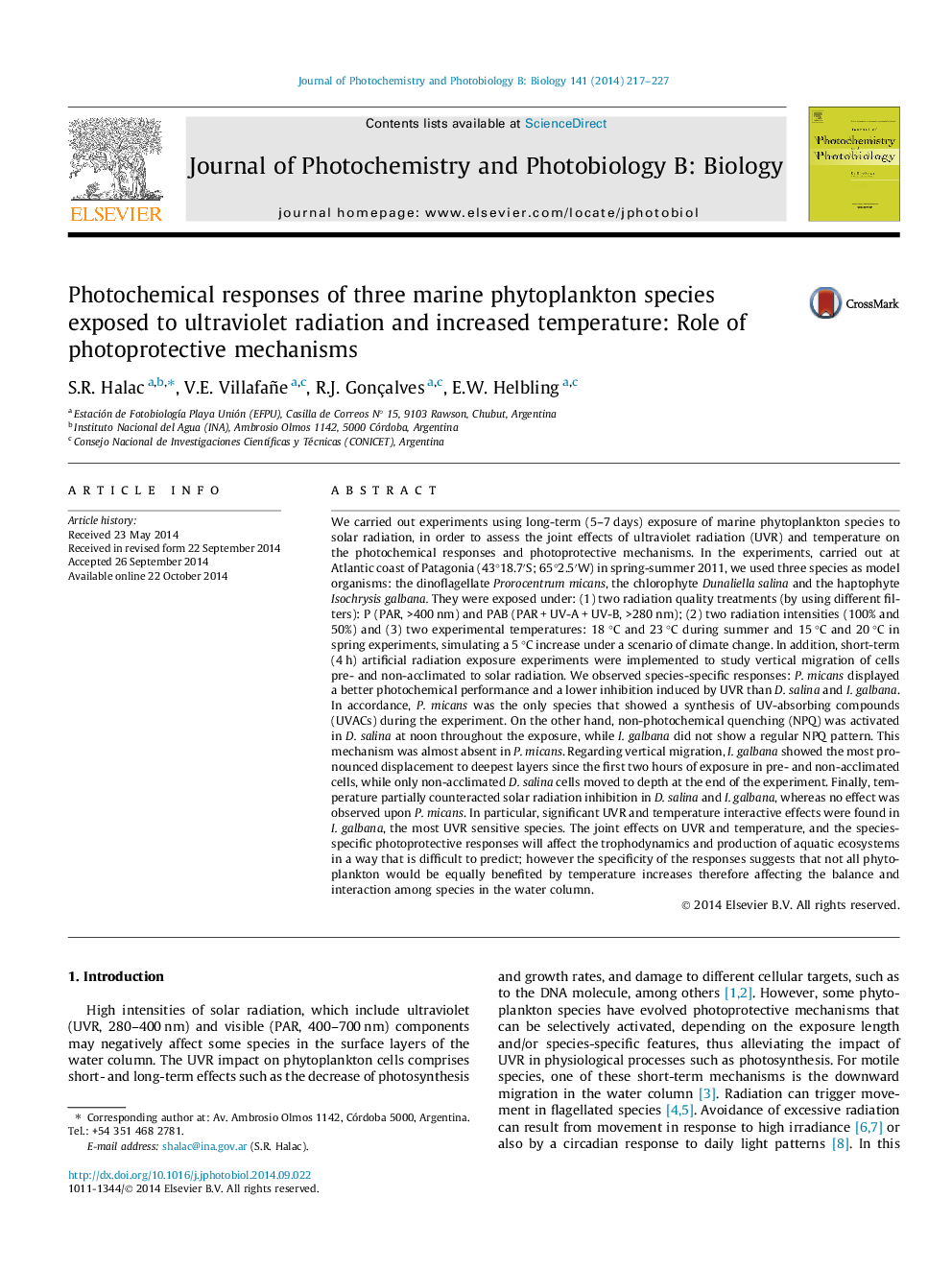| کد مقاله | کد نشریه | سال انتشار | مقاله انگلیسی | نسخه تمام متن |
|---|---|---|---|---|
| 29857 | 44444 | 2014 | 11 صفحه PDF | دانلود رایگان |
• P. micans showed the best photochemical response and highest UVR tolerance.
• UV absorbing compounds synthesis was an efficient photoprotective mechanism.
• Heat dissipation in D. salina contribute to decrease the UVR-induced inhibition.
• I. galbana was the most UVR sensitive species and showed downward migration.
• Temperature antagonistic effects were only detected in the UVR sensitive species.
We carried out experiments using long-term (5–7 days) exposure of marine phytoplankton species to solar radiation, in order to assess the joint effects of ultraviolet radiation (UVR) and temperature on the photochemical responses and photoprotective mechanisms. In the experiments, carried out at Atlantic coast of Patagonia (43°18.7′S; 65°2.5′W) in spring-summer 2011, we used three species as model organisms: the dinoflagellate Prorocentrum micans, the chlorophyte Dunaliella salina and the haptophyte Isochrysis galbana. They were exposed under: (1) two radiation quality treatments (by using different filters): P (PAR, >400 nm) and PAB (PAR + UV-A + UV-B, >280 nm); (2) two radiation intensities (100% and 50%) and (3) two experimental temperatures: 18 °C and 23 °C during summer and 15 °C and 20 °C in spring experiments, simulating a 5 °C increase under a scenario of climate change. In addition, short-term (4 h) artificial radiation exposure experiments were implemented to study vertical migration of cells pre- and non-acclimated to solar radiation. We observed species-specific responses: P. micans displayed a better photochemical performance and a lower inhibition induced by UVR than D. salina and I. galbana. In accordance, P. micans was the only species that showed a synthesis of UV-absorbing compounds (UVACs) during the experiment. On the other hand, non-photochemical quenching (NPQ) was activated in D. salina at noon throughout the exposure, while I. galbana did not show a regular NPQ pattern. This mechanism was almost absent in P. micans. Regarding vertical migration, I. galbana showed the most pronounced displacement to deepest layers since the first two hours of exposure in pre- and non-acclimated cells, while only non-acclimated D. salina cells moved to depth at the end of the experiment. Finally, temperature partially counteracted solar radiation inhibition in D. salina and I. galbana, whereas no effect was observed upon P. micans. In particular, significant UVR and temperature interactive effects were found in I. galbana, the most UVR sensitive species. The joint effects on UVR and temperature, and the species-specific photoprotective responses will affect the trophodynamics and production of aquatic ecosystems in a way that is difficult to predict; however the specificity of the responses suggests that not all phytoplankton would be equally benefited by temperature increases therefore affecting the balance and interaction among species in the water column.
Journal: Journal of Photochemistry and Photobiology B: Biology - Volume 141, December 2014, Pages 217–227
